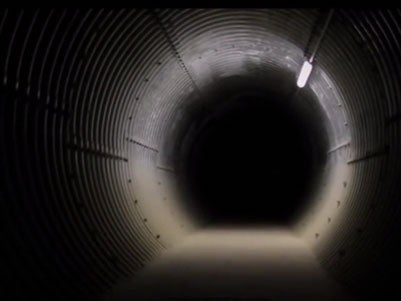Your support helps us to tell the story
From reproductive rights to climate change to Big Tech, The Independent is on the ground when the story is developing. Whether it's investigating the financials of Elon Musk's pro-Trump PAC or producing our latest documentary, 'The A Word', which shines a light on the American women fighting for reproductive rights, we know how important it is to parse out the facts from the messaging.
At such a critical moment in US history, we need reporters on the ground. Your donation allows us to keep sending journalists to speak to both sides of the story.
The Independent is trusted by Americans across the entire political spectrum. And unlike many other quality news outlets, we choose not to lock Americans out of our reporting and analysis with paywalls. We believe quality journalism should be available to everyone, paid for by those who can afford it.
Your support makes all the difference.A network of underground tunnels and bunkers used by the Nazis to develop an atomic bomb has been discovered in Austria by a filmmaker.
The complex was discovered just outside the small town of St Georgen an der Gusen, near Linz. Its exact location was determined using intelligence reports and radiation tests, which revealed higher than normal levels of radioactivity.
Andreas Sulzer, the filmmaker who is leading the exploration, discovered a critical 1944 report by the forerunner to the CIA, from an American spy who noted the existence of a secret weapons programme in the area.
The facility was built using slave labour from a nearby concentration camp, Mauthausen-Gusen.
Covering up to 75 acres, the vast site was believed to be connected to the underground Bergkristall factory, where the Messerschmitt Me 262, the first jet-powered fighter plane, was built.
Following the war, the factory was inspected by the Allies, but they never uncovered the well-hidden, secret complex.
Heavy earth moving equipment was required to break through the soil, concrete and granite blocks to unearth the entrance to the bunker.
Mr Sulzer told the Sunday Times: “Prisoners from concentration camps across Europe were handpicked for their special skills - physicists, chemists or other experts - to work on this monstrous project and we owe it to the victims to finally open the site and reveal the truth.”
He also said that the site is likely to have been the largest weapons facility in the Third Reich. The site and concentration camp were considered so important to the Nazis that the leader of the SS, Heinrich Himmler, visited in 1941.
Up to 320,000 slave labourers toiled and died working on the site from the Mauthausen-Gusen concentration camp in horrific underground conditions.
Police stopped excavations last week as the team did not have a permit to work on historical sites, but Mr Sulzer is confident that the dig can be restarted soon.
A number of historical artefacts, including SS helmets and Nazi relics, have already been recovered from the complex.

Join our commenting forum
Join thought-provoking conversations, follow other Independent readers and see their replies
Comments